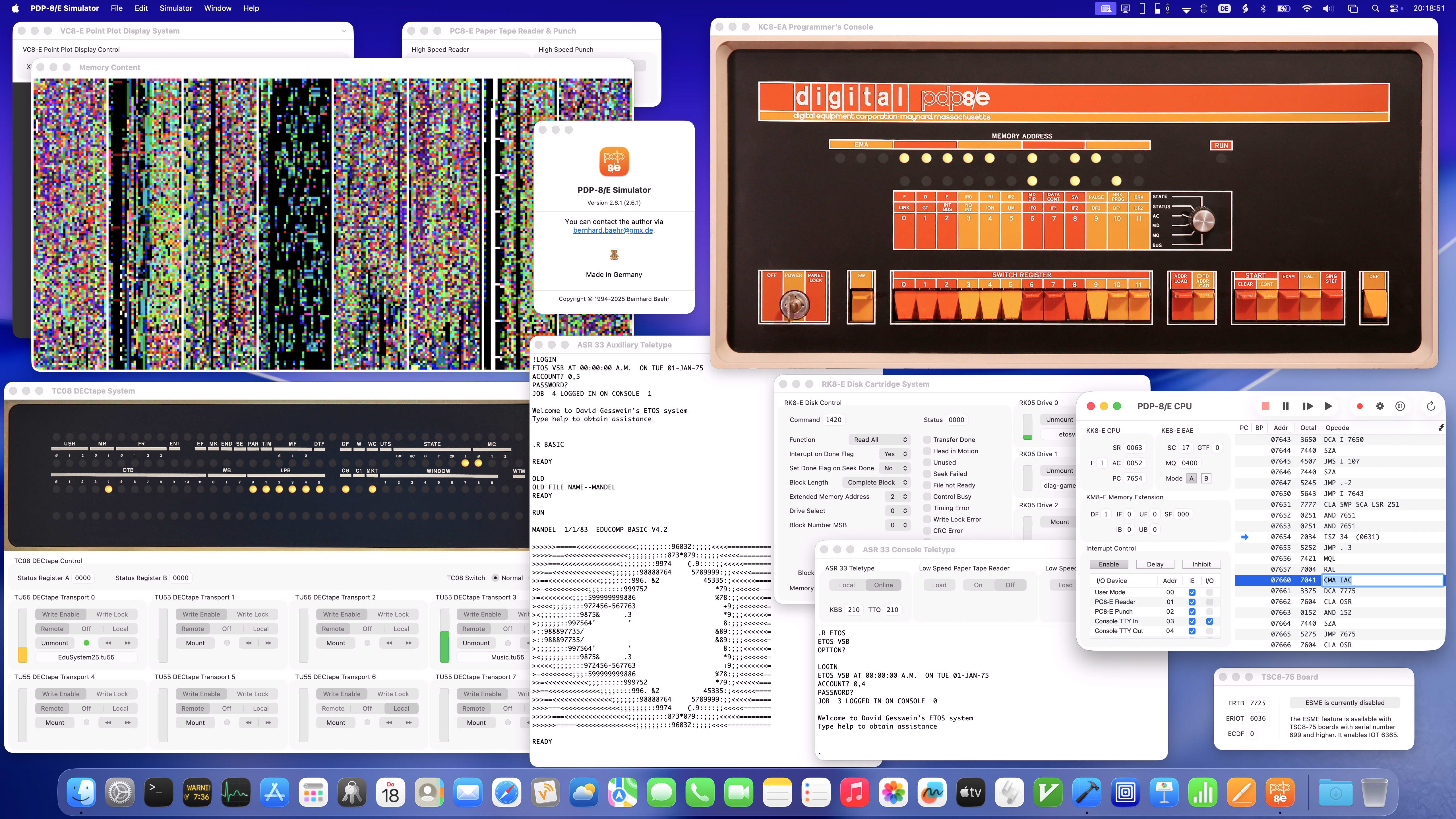
The simulated machine is a PDP-8/E with 4K words of memory and optionally a KM8-E Memory Extension (with up to 32K words of memory) and a KE8-E Extended Arithmetic Element. I/O devices are implemented as plug-in modules, and the simulator contains plug-ins for an ASR 33 Console Teletype, an ASR 33 Auxiliary Teletype, a PC8-E High Speed Paper Tape Reader and Punch, a RK8-E Disk Cartridge System, a TC08 DECtape System and various Real Time Clocks.
There is also a KC8-EA Programmer's Console plug-in enabling the user to operate the simulator (nearly) like a hardware PDP-8/E, including single step execution on memory cycle level.
Furthermore, the simulator has a plug-in for the TSC8-75 board so that the emulated PDP-8/E can run the ETOS time sharing operating system.
A Music Player plug-in enables the PDP-8/E Simulator to make audible the music played with the PDP-8 Music Playing Program (DECUS 8-804), and a VC8-E Point Plot Display System plug-in allows the simulator to run Spacewar.
The simulator provides a comfortable user interface for running, writing and debugging PDP-8 software. For each device, there is a separate window which displays the internal state of the device. The user can view and edit the PDP-8 memory content as octal dump, assembler instructions and typed data (ASCII, integer, floating point, …).
Other features of the simulator are breakpoints, break opcodes, single step execution, a trace mode for the PDP-8/E and much more. The emulated ASR 33 Teletypes provide all comfort of Macintosh text editor windows and optionally produce the sound of hardware typewriters.
Benchmarks show that the PDP-8/E Simulator outperforms a hardware PDP-8/E in orders of magnitude when running on reasonable current Macs. There are options to slow down the CPU and the I/O devices to the speed of the real hardware. The simulator passes all of the most important MAINDEC hardware diagnostics for the PDP-8/E.
The plug-in API is included with the download, as well as a Memory Content demo plug-in that graphically shows the PDP-8/E memory content of the running machine. So you can implement your own plug-ins and PDP-8/E devices using Xcode and Objective-C or Swift.
PDP-8/E Simulator 2.6.1 runs on Macs with macOS X 10.13 “High Sierra” or newer and fully supports Dark Mode and Macs with Apple silicon. It is a Cocoa reimplementation of the version 1.x for the “classic” Mac OS that was first released in 1994. This version in turn is based on the PDP-8/E emulator of Bill Haygood (out-dated version from 1993). All three emulators use the same well-proven PDP-8/E emulation engine.
The simulator package includes some PDP-8 software, e. g. a complete OS/8 system, FOCAL-8 and Pascal-S, an EduSystem 25 DECtape and a PAL-8 compatible cross-assembler. There are tutorials for a quick start with the PDP-8/E Simulator and for operating the KC8-EA Programmer’s Console.
For old Macs, there is still PDP-8/E Simulator 1.5.1 available that runs on 68K-, PowerPC- and Intel-based Macs with System 2.0.1 to Mac OS X 10.6 “Snow Leopard”. The screenshot at the left shows the simulator simultaneously running on Mac OS X 10.2 “Jaguar” and on a Mac Plus with System 2.0.1. The Mac Plus “Mr. T” is emulated by Mini vMac.
This is the quick start for PDP-8/E Simulator 1.x.
Note that PDP-8/E Simulator 1.x and the I/O devices can completely be controlled using AppleScript.
Read the history of the PDP-8/E Simulator and some user feedback.
Here are some links to other PDP-8 related resources.
The PDP-8/E Simulator is published under the conditions of the GNU General Public License.
| Bernhard Baehr | 24.09.2025 21:20:00 |